
List of Chinese dialects
Encyclopedia
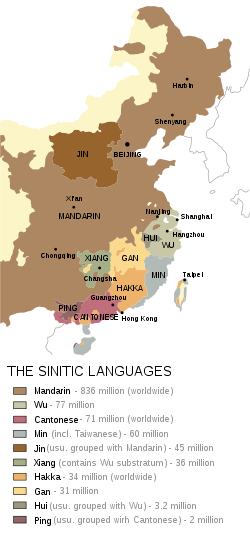
Chinese language
The Chinese language is a language or language family consisting of varieties which are mutually intelligible to varying degrees. Originally the indigenous languages spoken by the Han Chinese in China, it forms one of the branches of Sino-Tibetan family of languages...
s.
Classification
Linguists classify these languages as the Sinitic branch of the Sino-TibetanSino-Tibetan languages
The Sino-Tibetan languages are a language family comprising, at least, the Chinese and the Tibeto-Burman languages, including some 250 languages of East Asia, Southeast Asia and parts of South Asia. They are second only to the Indo-European languages in terms of the number of native speakers...
language family
Language family
A language family is a group of languages related through descent from a common ancestor, called the proto-language of that family. The term 'family' comes from the tree model of language origination in historical linguistics, which makes use of a metaphor comparing languages to people in a...
. Within this broad classification, linguistics identify between seven and fourteen subgroups.
Traditional classification
Traditional Chinese classification lists seven groups, comprising:| • Gan | (Jiangxinese) |
| • Guan | (Mandarin or Beifanghua) |
| • Kejia | (Hakka) |
| • Min | (including the Hokkien Hokkien Hokkien is a Hokkien word corresponding to Standard Chinese "Fujian". It may refer to:* Hokkien dialect, a dialect of Min Nan Chinese spoken in Southern Fujian , Taiwan, South-east Asia, and elsewhere.... and Taiwanese variants) |
| • Wu | (including the Shanghainese Shanghainese Shanghainese , or the Shanghai language , is a dialect of Wu Chinese spoken in the city of Shanghai and the surrounding region. It is classified as part of the Sino-Tibetan family of languages. Shanghainese, like other Wu dialects, is largely not mutually intelligible with other Chinese varieties... variant) |
| • Xiang | (Hunanese) |
| • Yue | (including the Cantonese Cantonese Cantonese is a dialect spoken primarily in south China.Cantonese may also refer to:* Yue Chinese, the Chinese language that includes Cantonese* Cantonese cuisine, the cuisine of Guangdong province... and Taishanese variants) |
(shown here with the romanized
Romanization
In linguistics, romanization or latinization is the representation of a written word or spoken speech with the Roman script, or a system for doing so, where the original word or language uses a different writing system . Methods of romanization include transliteration, for representing written...
Standard Chinese
Standard Chinese
Standard Chinese, or Modern Standard Chinese, also known as Mandarin or Putonghua, is the official language of the People's Republic of China and Republic of China , and is one of the four official languages of Singapore....
names of the categories, ordered alphabetically).
Modern linguistic classification
James MatisoffJames Matisoff
James A. Matisoff is a professor emeritus of Linguistics at the University of California, Berkeley and noted authority on Tibeto-Burman languages and other languages of mainland Southeast Asia....
’s widely accepted classification is as follows:
- Mandarin → Jin
- Wu → Huizhou
- Yue → Pinghua
- Min
- Xiang
- Hakka (Kejia)
- Gan
Matisoff's list uses the common English names of the groups, ordered by decreasing number of speakers of languages within the group.
Ethnologue
The EthnologueEthnologue
Ethnologue: Languages of the World is a web and print publication of SIL International , a Christian linguistic service organization, which studies lesser-known languages, to provide the speakers with Bibles in their native language and support their efforts in language development.The Ethnologue...
lists 14 language groups. In ISO 639-3 all beside Dungan are encoded as part of the Chinese 'macrolanguage' (zh/zho). The 14 languages are:
| ISO 639-3 ISO 639-3 ISO 639-3:2007, Codes for the representation of names of languages — Part 3: Alpha-3 code for comprehensive coverage of languages, is an international standard for language codes in the ISO 639 series. The standard describes three‐letter codes for identifying languages. It extends the ISO 639-2... |
Ethnologue name | Common name |
|---|---|---|
| Chinese, Gan | Gan | |
| Chinese, Hakka | Hakka | |
| Chinese, Huizhou | Huizhou | |
| Chinese, Jinyu | Jin | |
| Chinese, Mandarin | Mandarin | |
| Chinese, Min Bei | Min → Min Bei Min Bei The Min-Bei language, or Northern Min is a collection of dialects of Min spoken in Nanping Prefecture of northwestern Fujian which, apart from Shao-Jiang Min, are mutually intelligible.... |
|
| Chinese, Min Dong | Min → Min Dong Min Dong The Eastern Min language, or Min Dong is the language mainly spoken in the eastern part of Fujian Province in China, in and near Fuzhou and Ningde. Fuzhou is the province's capital and largest city... |
|
| Chinese, Min Nan | Min → Min Nan Min Nan The Southern Min languages, or Min Nan , are a family of Chinese languages spoken in southern Fujian, eastern Guangdong, Hainan, Taiwan, and southern Zhejiang provinces of China, and by descendants of emigrants from these areas in diaspora.... |
|
| Chinese, Min Zhong | Min → Min Zhong Min Zhong The Central Min language, or Min Zhong is a member of the Min subcategory of Chinese languages. It is spoken around Yong'an, Sanming and Sha located in the central mountain areas of Fujian. The total population of approximately 3,500,000 native speakers, is the fourth most common variety of the... |
|
| Chinese, Pu-Xian | Min → Pu–Xian | |
| Chinese, Wu | Wu | |
| Chinese, Xiang | Xiang | |
| Chinese, Yue | Yue | |
| Dungan | Mandarin → Dungan Dungan language The Dungan language is a Sinitic language spoken by the Dungan of Central Asia, an ethnic group related to the Hui people of China.-History:... |
See also Campbell's article on classifying Chinese dialects and ChinaDC's chart of Sino-Tibetan languages.
As the above categories illustrate, there are three common approaches to naming categories and languages in English:
- A RomanizationRomanizationIn linguistics, romanization or latinization is the representation of a written word or spoken speech with the Roman script, or a system for doing so, where the original word or language uses a different writing system . Methods of romanization include transliteration, for representing written...
of the name in Standard ChineseStandard ChineseStandard Chinese, or Modern Standard Chinese, also known as Mandarin or Putonghua, is the official language of the People's Republic of China and Republic of China , and is one of the four official languages of Singapore....
(e.g. "Gan" or "Xiang") - The common English name, where there is one (e.g. "Cantonese" or "Mandarin")
- A RomanizationRomanizationIn linguistics, romanization or latinization is the representation of a written word or spoken speech with the Roman script, or a system for doing so, where the original word or language uses a different writing system . Methods of romanization include transliteration, for representing written...
of the name in the local variety (e.g. "Hakka" or "Hokkien")
The classification used here is a combination of the classifications given above.
Distinction between dialects and languages
In addition to the languages and dialects listed below, it is customary to speak informally of dialects of each province, e.g. Sichuan dialectSichuan dialect
Sichuanese Mandarin , commonly known as Sichuanese, Szechuanese or Szechwanese , is a branch of Southwestern Mandarin, spoken mainly in Sichuan and Chongqing, which was part of Sichuan until 1997, and the adjacent regions of their neighboring provinces, such as Hubei, Guizhou, Yunnan, Hunan and...
, Hainan dialect. These designations do not generally correspond to classifications used by linguists, but each nevertheless has characteristics of its own.
The question of whether the various varieties of Chinese should be called dialects or languages in their own right is contentious. There are two principal uses of the word dialect
Dialect
The term dialect is used in two distinct ways, even by linguists. One usage refers to a variety of a language that is a characteristic of a particular group of the language's speakers. The term is applied most often to regional speech patterns, but a dialect may also be defined by other factors,...
. If varieties are considered dialects of a single language when they are mutually intelligible, and separate languages otherwise, then the principal branches of Chinese, and even some of the subbranches, are distinct languages. If, on the other hand, 'dialect' is used in its other meaning of a variety that is socially subordinate to a standardized or otherwise prestigious variety, perhaps one that shares a common written language
Written language
A written language is the representation of a language by means of a writing system. Written language is an invention in that it must be taught to children, who will instinctively learn or create spoken or gestural languages....
and literature
Literature
Literature is the art of written works, and is not bound to published sources...
with the prestige form, then they are all dialects of a single Chinese language, though Cantonese
Cantonese
Cantonese is a dialect spoken primarily in south China.Cantonese may also refer to:* Yue Chinese, the Chinese language that includes Cantonese* Cantonese cuisine, the cuisine of Guangdong province...
and to a lesser extent Shanghainese
Shanghainese
Shanghainese , or the Shanghai language , is a dialect of Wu Chinese spoken in the city of Shanghai and the surrounding region. It is classified as part of the Sino-Tibetan family of languages. Shanghainese, like other Wu dialects, is largely not mutually intelligible with other Chinese varieties...
and Taiwanese are local prestige forms with use in the media and a nascent literature.
Gan – 赣语/贛語
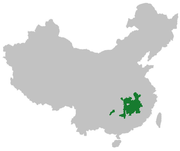
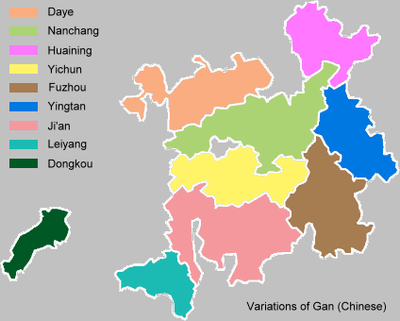
| • Huaining dialect
| • Fuzhou (Jiangxi) dialect
| • Ji'an (Jiangxi) dialect
| • Leiyang dialect
| • Nanchang dialect
Nanchang dialect
Chang-Du dialect, sometimes called Nanchang dialect after its principal variety, is a dialect of the Gan language. It is named after Nanchang and Duchang, and is spoken in those areas as well as in Xinjian, Anyi, Yongxiu, De'an, Xingzi, Hukou, and bordering regions in Jiangxi province and in...
| • Xianning dialect
| • Yichun dialect
Yichun dialect
Yi-Liu, sometimes called Yichun dialect after its principal variety, is a dialect of the Gan language. It is spoken in Yichun in Jiangxi province and in Liuyang in Hunan, after which it is named, as well as inShanggao, Qingjiang, Xingan, Xinyu City, Fen yi, Pingxiang City, Fengcheng, Wanzai in...
| • Yingtan dialect
Guan (Mandarin) – 官话/官話
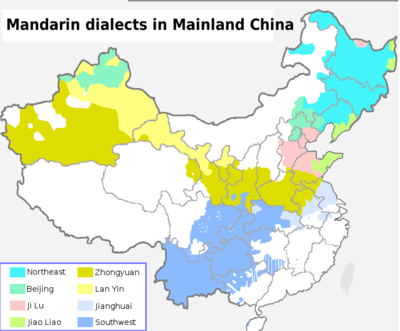
|Beijing mandarin >
>-
|-bgcolor="FFFFFF"
| • Beijing dialect
Beijing dialect
Beijing dialect, or Pekingese , is the dialect of Mandarin spoken in the urban area of Beijing, China. It is the phonological basis of Standard Chinese, which is used by the People's Republic of China, the Republic of China , and Singapore....
| • Standard Chinese
Standard Chinese
Standard Chinese, or Modern Standard Chinese, also known as Mandarin or Putonghua, is the official language of the People's Republic of China and Republic of China , and is one of the four official languages of Singapore....
國語 Guoyu
Guoyu
Guoyu may mean or refer to:Language* the common term in Taiwan and Hong Kong for Standard Chinese, based on Mandarin Chinese* the Xianbei language during the Northern Wei Dynasty before its sinicization...
(ROC
ROC
Roc may refer to:*Roc , a mythical giant bird*Roc , a role-playing version of the mythical bird*Roc , an American television sitcom starring Charles S...
)
华语 Huayu (Singapore
Singapore
Singapore , officially the Republic of Singapore, is a Southeast Asian city-state off the southern tip of the Malay Peninsula, north of the equator. An island country made up of 63 islands, it is separated from Malaysia by the Straits of Johor to its north and from Indonesia's Riau Islands by the...
)
>-
| • Chengde dialect
| • Chifeng dialect
| • Hailar dialect
| • Karamay dialect
Karamay dialect
Karamay dialect is a Beijing Mandarin dialect spoken in northern Xinjiang, China. It is also known as North Xinjiang Area dialect , the regions of which include Karamay, Shihezi, Burqin County, Toli County, Hoboksar Mongol Autonomous County, Wenquan County in northern Xinjiang and a few other...
|-bgcolor="E6E6FA"
|Ji–Lu Mandarin
>-
| • Baoding dialect
| • Jinan dialect
Jinan dialect
Jinan dialect is a dialect of the Mandarin language family, which in turn constitutes one of the Sinitic language families. It is spoken in Jinan in Shandong province.-Consonants:-Tones:-References:...
| • Shijiazhuang dialect
| • Tianjin dialect
Tianjin dialect
Tianjin dialect is a Mandarin dialect spoken in the urban area of Tianjin, China. It is comprehensible to speakers of other Mandarin dialects, though its greatest deviation from the others lies in its individual tones, and the lack of retroflex consonants...
|-bgcolor="E6E6FA"
|Jianghuai Mandarin
>-
| • Hefei dialect
| • Hainan Junjiahua
| • Nanjing dialect
Nanjing dialect
Nanjing dialect or Nanjing Mandarin is a dialect of Jianghuai Mandarin which is spoken in the city of Nanjing in China.-Family:Nanjing dialect is a dialect of Jianghuai Mandarin, which belongs to the broader Mandarin Chinese family, which is a Sinitic language like all other Chinese...
| • Nantong dialect
| • Xiaogan dialect
| • Yangzhou dialect
|Jiao–Liao Mandarin
>-
| • Dalian dialect
Dalian dialect
Dalian dialect is the dialect of Mandarin spoken on the Liaodong Peninsula, including the city of Dalian and parts of Dandong and Yingkou. Dalian dialect shares many similarities with the Qingdao dialect spoken on Shandong Peninsula across Bohai Strait; hence the name Jiao Liao Mandarin...
| • Qingdao dialect
Qingdao dialect
Qingdao dialect is the local dialect of the city of Qingdao, in China's Shandong Province.Often characterized as requiring a "fat tongue", the Qingdao dialect often adds a "th" sound to Mandarin's "sh", "x", and "s"...
| • Weihai dialect
Weihai dialect
Weihai dialect is a dialect of Mandarin spoken in and around the city of Weihai, in eastern Shandong province....
| • Yantai dialect
|-bgcolor="E6E6FA"
|Lan–Yin Mandarin
>-
| • Lanzhou dialect
| • Urumqi dialect
|-
| • Xining dialect
| • Yinchuan dialect
|-bgcolor="E6E6FA"
|Northeastern Mandarin
Northeastern Mandarin
Northeastern Mandarin is the dialect of Mandarin Chinese spoken in what historically was Manchuria. It is very similar to the Beijing dialect upon which Standard Chinese is based.-Geographical spread:...
>-
| • Changchun dialect
| • Harbin dialect
Harbin dialect
The Harbin dialect is a variety of Mandarin Chinese spoken in and around the city of Harbin, the capital of Heilongjiang province.-Characteristics:...
| • Qiqihar dialect
| • Shenyang dialect
Shenyang Dialect
Shenyang Mandarin is a dialect of Northeastern Mandarin used by people in and around Shenyang, the capital of Liaoning province and the largest city in Northeast China. It is very close to Standard Chinese but has some notably distinctive words. Some people think of it as a strong accent rather...
|-bgcolor="E6E6FA"
|Southwestern Mandarin
Southwestern Mandarin
Southwestern Mandarin , also known as Upper Yangtze Mandarin , is a primary branch of Mandarin Chinese spoken by Han Chinese people throughout many regions of central and southwestern China, such as Sichuan, Yunnan, Chongqing, Guizhou, most parts of Hubei, the western part of Hunan, the northern...
>-
| • Changde dialect
| • Chengdu dialect
| • Chongqing dialect
| • Dali dialect
| • Guiyang dialect
| • Kunming dialect
Kunming dialect
The Kunming dialect is an official dialect of Southwestern Mandarin Chinese. Luo Changpei describes it as having "simple phonemes, elegant vocabulary, and clear grammar. "-Beginnings:...
| • Liuzhou dialect
| • Wuhan dialect
| • Xichang dialect
| • Yichang dialect
|-bgcolor="E6E6FA"
|Zhongyuan Mandarin
Zhongyuan Mandarin
Central Plains or Zhongyuan Mandarin is a dialect of Mandarin Chinese spoken in the central part of Shaanxi, Henan, and southern part of Shandong.The archaic dialect of Peking opera is a form of Zhongyuan Mandarin....
>-
| • Dungan language
Dungan language
The Dungan language is a Sinitic language spoken by the Dungan of Central Asia, an ethnic group related to the Hui people of China.-History:...
| • Hanzhong dialect
| • Kaifeng dialect
| • Kashgar dialect of Chinese
| • Luoyang dialect
Luoyang dialect
The Luoyang dialect is a dialect of Zhongyuan Mandarin spoken in Luoyang and nearby parts of Henan province. Although it served as the prestige dialect of Chinese from the Warring States Period into the Ming Dynasty, it differs greatly from modern Standard Mandarin, which is based instead on the...
| • Nanyang dialect
| • Qufu dialect
| • Tianshui dialect
| • Xi'an dialect
Guanzhong Hua
Guanzhong dialect , is a dialect of Zhongyuan Mandarin spoken in Shaanxi's Guanzhong region, including the prefecture-level city of Xi'an. Since people from Xi'an are considered the prototypical Guanzhong speakers, Guanzhong dialect is sometimes referred to as Shaanxi hua 陕西话 or Xi'an hua 西安话...
| • Xuzhou dialect
Xuzhou dialect
Xuzhou dialect is a dialect of Mandarin Chinese. It is spoken in the city of Xuzhou in Jiangsu province of China.Jiangsu has two basic dialect types, that of the south, influenced by Wu and that of the north. Beginning roughly in the area extending from Changzhou to Danyang there is a change in...
| • Yan'an dialect
| • Zhengzhou dialect
Hui – 徽語
Sometimes subcategory of Wu.| • Shexian (Anhui) dialect
| • Tunxi dialect
| • Yixian (Anhui) dialect
Jin – 晋语/晉語
Sometimes subcategory of Mandarin.| • Datong dialect
| • Handan dialect
| • Hohhot dialect
| • Taiyuan dialect
| • Xinxiang dialect
Kejia (Hakka) – 客家話
| • Meizhou dialect
| • Wuhua dialect
Wuhua dialect
Wuhua is a major dialect of Hakka Chinese. It is characterized by the pronunciation of many voiced Middle Chinese qu-sheng syllables of Moiyen dialect in the shang-sheng . The tone-level of the yang-ping is a rising /13/ instead of the low-level /11/ usually found in Moiyen...
| • Xingning dialect
| • Pingyuan dialect
| • Jiaoling dialect
| • Dabu dialect
| • Fengshun dialect
| • Longyan dialect
| • Lufeng (Hakka) dialect
Min – 閩語/闽语
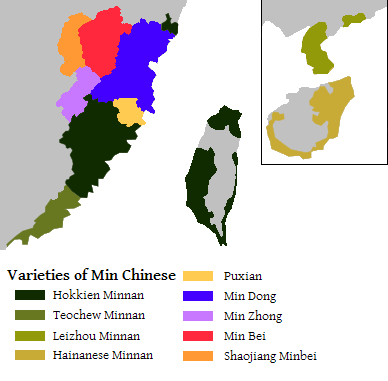
|Min Bei
Min Bei
The Min-Bei language, or Northern Min is a collection of dialects of Min spoken in Nanping Prefecture of northwestern Fujian which, apart from Shao-Jiang Min, are mutually intelligible....
(Northern Min) >
>-
| • Jian'ou dialect
Jian'ou dialect
Jian'ou is a local standard common language of Northern Min Chinese spoken in Jian'ou in the north of the Fujian province.-Consonants:-Citation tones:Jian'ou has four tones, which are reduced to two in checked syllables.-References:...
|Shao–Jiang Min
>-bgcolor="E6E6FA"
|Min Dong
Min Dong
The Eastern Min language, or Min Dong is the language mainly spoken in the eastern part of Fujian Province in China, in and near Fuzhou and Ningde. Fuzhou is the province's capital and largest city...
(Eastern Min)
>-
| • Fu'an dialect
| • Fuding dialect
| • Xiapu dialect
| • Shouning dialect
| • Zhouning dialect
| • Ningde dialect
| • Zherong dialect
| • Fuzhou dialect
Fuzhou dialect
Fuzhou dialect , also known as Foochow dialect, Foochow, Foochowese, Fuzhounese, or Fuzhouhua, is considered the standard dialect of Min Dong, which is a branch of Min Chinese mainly spoken in the eastern part of Fujian Province. Native speakers also call it ' , meaning the language spoken in...
(Hók-ciŭ-uâ)
| • Minhou dialect
| • Yongtai dialect
| • Minqing dialect
| • Changle dialect
| • Luoyuan dialect
| • Lianjiang dialect
| • Fuqing dialect (Hók-chiăng-uâ)
| • Pingtan dialect
| • Pingnan dialect
| • Gutian dialect
|-bgcolor="E6E6FA"
| Min Nan
Min Nan
The Southern Min languages, or Min Nan , are a family of Chinese languages spoken in southern Fujian, eastern Guangdong, Hainan, Taiwan, and southern Zhejiang provinces of China, and by descendants of emigrants from these areas in diaspora....
(Southern Min)
>-
|-bgcolor="f0f0fa"
| • Hokkien
Hokkien
Hokkien is a Hokkien word corresponding to Standard Chinese "Fujian". It may refer to:* Hokkien dialect, a dialect of Min Nan Chinese spoken in Southern Fujian , Taiwan, South-east Asia, and elsewhere....
(Mintai division)
| • Quanzhou dialect
Quanzhou dialect
The Quanzhou dialect is a Hokkien dialect which originally comes from Southern Fujian province , in the area centered around the city of Quanzhou. Among the Taiwanese who migrated came from Fujian province since the 17th century onwards, 44.8% were originally from Quanzhou whereas 35.1% were from...
| • Amoy
| • Taiwanese (see regional variations)
| • Lan-nang dialect (Filipino Hokkien)
| • Zhangzhou dialect
Zhangzhou dialect
The Zhangzhou dialect is a Hokkien dialect originating from southern Fujian province , in the area centered around the city of Zhangzhou. Among the Taiwanese who migrated from Fujian province starting in the 17th century, 35.1% were originally from Zhangzhou whereas 44.8% were from Quanzhou...
| • Singaporean Hokkien
Singaporean Hokkien
Singaporean Hokkien is a local variant of the Hokkien dialect spoken in Singapore. It is closely related to the Southern Malaysian Hokkien spoken in Southern Malaysia as well as Riau Hokkien spoken in the Indonesian province of Riau...
| • Penang Hokkien
Penang Hokkien
Penang Hokkien is a local variant of Hokkien spoken in Penang, Malaysia. It is the lingua franca among the majority Chinese population in Penang as well as other northern states of Malaysia surrounding it, and is characterised by the pronunciation of words according to the Zhangzhou dialect,...
| • Muar Hokkien
| • Medan Hokkien
Medan Hokkien
Medan Hokkien is a local variant of Hokkien spoken in Medan, Indonesia. It is the lingua franca in Medan as well as other northern city states of North Sumatra surrounding it, and is characterised by the pronunciation of words according to the Zhangzhou dialect, together with widespread use of...
|-bgcolor="f0f0fa"
| • Zhenan division
| • Longhai dialect
| • Zhangpu dialect
| • Anxi dialect
| • Hui'an dialect
Hui'an dialect
The Hui'an dialect, is a dialect mostly spoken in Hui'an in Fujian Province, China. It is a sub-dialect of Min Nan Chinese, and a sub-dialect of Zhenan Min.-See also:*List of Chinese dialects...
| • Tong'an dialect
|-bgcolor="f0f0fa"
| • Teochew (Chaoshan division)
| • Chaozhou dialect
| • Shantou dialect
Shantou dialect
The Shantou dialect, formerly known as the Swatow dialect, is a dialect mostly spoken in Shantou in Guangdong, China. It is a sub-dialect of Min Nan Chinese, and sometimes a sub-dialect of Teochew Min.-See also:*List of Chinese dialects...
(Swatow)
| • Chaoyang dialect
| • Puning dialect
| • Huilai dialect
| • Hailufeng dialect
| • Bangkok Teochew
|-bgcolor="f0f0fa"
| • Zhongshan Min division
| • Longdu dialect
Longdu dialect
The Longdu dialect is a dialect of the Zhongshan Min division of Southern Min Chinese, located in the Dachong and Shaxi area of Zhongshan in the Pearl River Delta of Guangdong. Despite its close proximity, Longdu is not very closely related to the surrounding dialects in the region, which belong...
| • Nanlang dialect
Nanlang dialect
The Nanlang dialect, is a dialect mostly spoken in Nanlang in Guangdong, China. It is a sub-dialect of Min Nan Chinese, more specifically of Zhongshan Min.-See also:*List of Chinese dialects...
| • Sanxiang dialect
Sanxiang dialect
The Sanxiang dialect, is a dialect mostly spoken in Sanxiang in Guangdong, China. It is a sub-dialect of Min Nan Chinese, more specifically of Zhongshan Min.-See also:*List of Chinese dialects...
| • Zhangjiabian dialect
|Min Zhong
Min Zhong
The Central Min language, or Min Zhong is a member of the Min subcategory of Chinese languages. It is spoken around Yong'an, Sanming and Sha located in the central mountain areas of Fujian. The total population of approximately 3,500,000 native speakers, is the fourth most common variety of the...
(Central Min)
>-
| • Yong'an dialect
| • Sanming dialect
| • Sha dialect
|-bgcolor="E6E6FA"
|Pu–Xian Min
>-
| • Putian dialect
| • Xianyou dialect
|-bgcolor="E6E6FA"
|Qiong Wen
>-
| • Hainan dialect (Hainanese)
|-bgcolor="E6E6FA"
|Leizhou
Leizhou
Leizhou City is a county-level city in Guangdong province, in southern China.It is under the jurisdiction of Zhanjiang prefecture-level city.-See also:* Leizhou dialect...
>-
| • Leizhou dialect
Leizhou dialect
Leizhou is a variety of Min Nan Chinese. It is spoken in the Leizhou city and its neighbouring areas on the Leizhou peninsula in the west of the Guangdong province...
| • Zhanjiang dialect
Zhanjiang dialect
The Zhanjiang dialect is a dialect mostly spoken in Zhanjiang in Guangdong, China. It is a sub-dialect of Min Nan Chinese, and sometimes a sub-dialect of Leizhou Min.-See also:*List of Chinese dialects...
Wu – 吴语/吳語
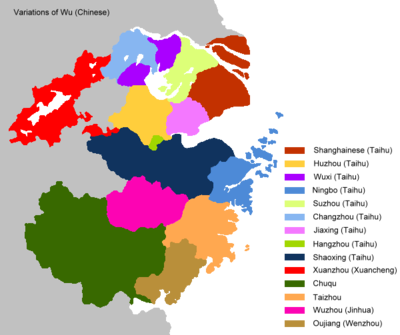
|Taihu
Taihu Wu dialects
Taihu Wu dialects , or Northern Wu dialects , are a group of Wu dialects spoken over much of southern part of Jiangsu province, including Suzhou, Wuxi, Changzhou, the southern part of Nantong, Jingjiang and Danyang; the municipality of Shanghai; and the northern part of Zhejiang province, including...
>
>-
| • Changzhou dialect
Changzhou dialect
Changzhou dialect is a dialect of Wu, a Sino-Tibetan language, and belongs to the Taihu dialect group. It is spoken in the city of Changzhou and surrounding areas in Jiangsu province of China. It has many similarities with the Shanghainese and Suzhou dialect, but is largely not comprehensible...
| • Suzhou dialect
Suzhou dialect
Suzhou dialect is a dialect of Wu, one of the subdivisions of Chinese spoken language. It is spoken in the city of Suzhou, in Jiangsu province of China, and is the traditional prestige dialect of Wu....
| • Wuxi dialect
Wuxi dialect
Wuxi dialect is a dialect of Wu. It is spoken in the city of Wuxi in Jiangsu province of China....
| • Hangzhou dialect
Hangzhou dialect
The Hangzhou dialect, or Rhangzei Rhwa , is spoken in the city of Hangzhou and its immediate suburbs, but excluding areas further away from Hangzhou such as Xiāoshān and Yúháng . The number of speakers of the Hangzhou dialect has been estimated to be about 1.2 to 1.5 million...
| • Huzhou dialect
| • Jiaxing dialect
| • Shaoxing dialect
| • Ningbo dialect
Ningbo dialect
Ningbo dialect is a dialect of Wu, one of the subdivisions of Chinese spoken language. It is spoken in the city of Ningbo and Zhoushan and surrounding areas in Zhejiang province.-Area:...
| • Shanghai dialect
|-bgcolor="E6E6FA"
|Taizhou
Taizhou Wu dialects
Taizhou Wu dialects are a group of Southern Wu dialects spoken in in and around Taizhou in Zhejiang province. They are to some extent mutually intelligible with Taihu Wu.-Dialects:Taizhou proper is the chief and representative dialect.*Taizhou dialect...
>-
| • Taizhou dialect
Taizhou dialect
Taizhou dialect is a dialect of Wu, one of the Chinese languages. It is spoken in the city of Taizhou in Zhejiang province of China. It is not mutually intelligible with Mandarin Chinese, and only partially intelligible with Shanghainese.-Consonants:*m、ng are also syllables-Vowels:...
| • Linhai dialect
| • Sanmen dialect
| • Tiantai dialect
| • Xianju dialect
| • Huangyan dialect
| • Jiaojiang dialect
|-bgcolor="E6E6FA"
|Oujiang (Dong'ou)
>-
| • Wenzhou dialect
Wenzhou dialect
Wenzhounese or Oujiang is the speech of Wenzhou, the southern prefecture of Zhejiang Province, China. It is the most divergent division of Wu Chinese, and is sometimes considered a separate language. It features noticeable elements of Min, which borders it to the south...
| • Rui'an dialect
| • Wencheng dialect
|-bgcolor="E6E6FA"
|Wuzhou
Wuzhou Wu dialects
Wuzhou Wu dialects are a group of Southern Wu dialects spoken in in and around Jinhua in Zhejiang province. They are mutually intelligible with Taihu Wu to at least some degree.-Dialects:Jinhua is the chief and representative dialect of Taizhou....
>-
| • Jinhua dialect
| • Lanxi dialect
| • Pujiang dialect
| • Yiwu dialect
| • Dongyang dialect
| • Pan'an dialect
| • Yongkang dialect
| • Wuyi dialect
| • Jiande dialect
|-bgcolor="E6E6FA"
|Chuqu
Chuqu Wu dialects
Chuqu Wu dialects are a group of Southern Wu dialects spoken in Southern Zhejiang in Quzhou and Lishui prefectures, as well as some parts of Southern Wenzhou prefecture...
>-
| • Lishui dialect
| • Qingtian dialect
Qingtian dialect
Qingtian dialect is a spoken dialect of the Chinese language. It is spoken in Qingtian county of Lishui prefecture in Zhejiang, China. Qingtian dialect is of the Chuqu Wu dialects spoken in Quzhou and Lishui prefectures of Zhejiang....
| • Quzhou dialect
Quzhou dialect
Quzhou Dialect is a dialect of Wu Chinese spoken in Quzhou.-Initials:-Rimes:There are at least the following rimes:姆 , 魚 , 爾 , 試 水 , 去 , 布 , 雨 家 , 謝 , 瓜 菜 , 快 走 , 會 包 , 表 勾 , 九 南 , 官 , 捐 變 三 , 慣...
| • Shangrao dialect
|-bgcolor="E6E6FA"
|Xuanzhou
Xuanzhou Wu dialects
Xuanzhou Wu is an eastern branch of Wu Chinese spoken in and around Xuancheng, Anhui province. The dialect has declined since the Taiping Rebellion, with an influx of Mandarin-speaking immigrants from north of Yangtse river.-Dialects:...
>-
| • Xuancheng dialect
Xiang – 湘语/湘語/湖南话/湖南話
|Chang–Yi dialects >
>-
| • Changsha dialect
Changsha dialect
Changsha dialect is a dialect of Xiang Chinese, which is one of the Sinitic languages. It is spoken predominantly in Changsha, the capital of Hunan province. It is not mutually intelligible with Mandarin, the official language of China.-Classification:...
| • Yueyang dialect
| • Hengyang dialect
| • Hengnan dialect
| • Hengshan dialect
| • Hengdong dialect
| • Qidong dialect
| • Qiyang dialect
Qiyang dialect
Qiyang dialect is a dialect of Xiang Chinese spoken in Qiyang County, Hunan province.-Tones:Qiyang dialect is quite unusual in that it is reported to have two "double contour" tones, high and low fall–rise–fall, or perhaps high fall – low fall and low fall – high fall: the entering tones yin qu ...
| • Leiyang dialect
| • Changning dialect
| • Yiyang dialect
| • Ningxiang dialect
| • Zhuzhou dialect
| • Changde dialect
| • Pingjiang dialect
|-bgcolor="E6E6FA"
|Lou–Shao dialects
>-
| • Loudi dialect
| • Shaoyang dialect
| • Shuangfeng dialect
Shuangfeng dialect
Shuangfeng dialect is a dialect of Xiang Chinese, spoken in Shuangfeng County, Hunan province.-Consonants:-Tones:Phonemically, Shuangfeng dialect has three tones. However, phonetically the pitch of a syllable depends on the voicing of the initial consonant, so that these are counted as...
|-bgcolor="E6E6FA"
|Chen–Xu dialects
>-
| • Chenxi dialect
| • Xupu dialect
Yue – 粵語/粤语
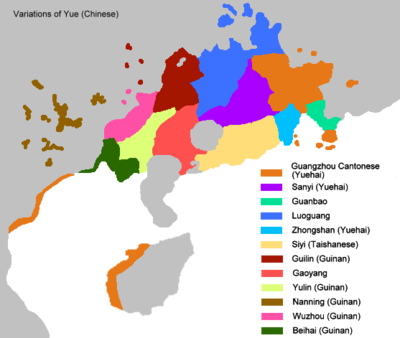
|Yuehai dialect >
>-bgcolor="d5e3f4"
|Cantonese
Cantonese
Cantonese is a dialect spoken primarily in south China.Cantonese may also refer to:* Yue Chinese, the Chinese language that includes Cantonese* Cantonese cuisine, the cuisine of Guangdong province...
(Guangfu)
| • Hong Kong Cantonese
Hong Kong Cantonese
Hong Kong Cantonese is a form of Yue Chinese commonly spoken in Hong Kong. Although Hongkongers largely identify this variant of Chinese with the term "Cantonese" , a variety of publications in mainland China describe the variant as Hong Kong speech...
| • Vietnamese Cantonese
| • Wuzhou dialect
| • Tanka dialect
>-
|-bgcolor="d5e3f4"
|Sanyi dialect (Samyap)
| • Nanhai dialect
| • Jiujiang dialect
Jiujiang dialect
Jiujiang dialect is a variety of Cantonese. It is spoken with a low pitch accent. Juijiang speakers say "ngai" as a pronoun for the word, "我" instead of saying "ngo" in Standard Cantonese. As well, they say "hao" for the word, "好" but Guangzhou speakers say "ho". A few words differ from the...
| • Xiqiao dialect
| • Panyu dialect
| • Shunde dialect
|-bgcolor="d5e3f4"
|Zhongshan dialect
| • Shiqi dialect
Shiqi dialect
Shiqi dialect is a dialect of Yue Chinese. It is spoken by roughly 160,000 people in Zhongshan, Guangdong's Shiqi urban district. It differs slightly from Cantonese, mainly in its pronunciation and lexicon....
| • Sanjiao dialect
|-bgcolor="8dc0ff"
|Guan-Bao dialect
>-
| • Dongguan dialect
| • Bao'an dialect (Waitau)
|-bgcolor="8dc0ff"
|Yong–Xun dialects (Jungcam)
>-
| • Nanning dialect
| • Yongning dialect
| • Guiping dialect
| • Chongzuo dialect
| • Ningmin dialect
| • Hengxian dialect
| • Baise dialect
|-bgcolor="8dc0ff"
|Goulou dialects
Goulou dialects
Goulou Yue is a western Guinan branch of Yue Chinese spoken around the Guangxi–Guangdong border.-Dialects:Yulin dialect is representative.*Yulin dialect*Guangning dialect*Huaiji dialect*Fengkai dialect*Deqing dialect*Yunan dialect...
(Ngaulau)
>-
| • Yulin dialect
| • Guangning dialect
| • Huaiji dialect
| • Fengkai dialect
| • Deqing dialect
| • Yunan dialect
| • Shanglin dialect
| • Binyang dialect
| • Tengxian dialect
|-bgcolor="8dc0ff"
|Luo–Guang dialects
>-
| • Luoding dialect
>-
| • Zhaoqing dialect
| • Sihui dialect
| • Yangshan dialect
| • Lianzhou dialect
| • Lianshan dialect
| • Qingyuan dialect
|-bgcolor="8dc0ff"
|Siyi dialect
Siyi dialect
Siyi is a coastal branch of Yue Chinese spoken in Guangdong province. It includes Taishanese, one of the most important Chinese dialects in American Chinese communities.-Dialects:Taishanese dialect is representative.*Taishan dialect...
(Seiyap)
>-
| • Taishan dialect
Taishan dialect
Taishanese is a dialect of Yue Chinese. The dialect is closely related to Cantonese.Taishanese is spoken in the southern part of Guangdong Province in China, particularly in and around the city-level county of Taishan...
| • Xinhui dialect
| • Siqian dialect
| • Guzhen dialect
| • Enping dialect
| • Kaiping dialect
|-bgcolor="8dc0ff"
|Gao–Yang dialects
>-
| • Gaozhou dialect
| • Yangjiang dialect
|-bgcolor="8dc0ff"
|Qin–Lian dialects (Jamlim)
>-
| • Beihai dialect
| • Qinzhou dialect
| • Fangchenggang dialect
| • Lianzhou dialect
| • Lingshan dialect
|-bgcolor="8dc0ff"
|Wu–Hua dialects (Ngfaa)
>-
| • Wuchuan dialect
| • Huazhou dialect
|-bgcolor="8dc0ff"
|Hainan Yue
Hainan Yue
The Yue Chinese of Hainan Island, known as Hainan Yue , constitutes two dialects of disputed classification, Danzhou and Mai....
>-
| • Danzhou dialect
| • Mai dialect
Ba-Shu – 巴蜀語
|Ba-Shu Chinese
Ba-Shu Chinese
Ba-Shu Chinese or Old Sichuanese , is an extinct Sinitic language spoken in what is now Sichuan province and Chongqing municipality of China. This language was first attested during the Western Han dynasty and represents one of the first splits from Old Chinese or Early Middle Chinese...
>
Unclassified
| Maojia dialect
| Shaozhou Tuhua
Shaozhou Tuhua
Shaozhou Tuhua , or simply Tuhua, is an unclassified Chinese language spoken in the border region of the provinces Guangdong, Hunan and Guangxi...
| Wutun language
| Tangwang language
Tangwang language
The Tangwang language is a variety of Mandarin Chinese heavily influenced by the Mongolic Dongxiang language. It is spoken in a dozen or so villages in Dongxiang Autonomous County, Gansu Province, China. The linguist Mei W...
See also
- Chinese languageChinese languageThe Chinese language is a language or language family consisting of varieties which are mutually intelligible to varying degrees. Originally the indigenous languages spoken by the Han Chinese in China, it forms one of the branches of Sino-Tibetan family of languages...
- Chinese spoken language
- Chinese written languageChinese written languageWritten Chinese comprises Chinese characters used to represent the Chinese language, and the rules about how they are arranged and punctuated. Chinese characters do not constitute an alphabet or a compact syllabary...
- Dialects of Mandarin
- Dialect (discussion of "dialect" or "language")
- Identification of the varieties of Chinese

